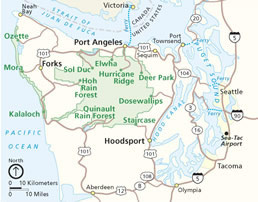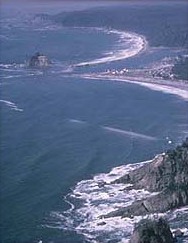Olympic Peninsula
Olympic Peninsula is a large arm of land in western Washington, in the United States. It is bounded by the Pacific Ocean to the west, the Strait of Juan de Fuca to the north, and the Puget Sound to the east. The peninsula covers an area that includes many diverse ecosystems, ranging from the temperate rainforests in the west, to the alpine regions in the center, and the drier shadow forests and coastal areas. It is home to the Olympic National Park, a UNESCO World Heritage Site, which encompasses the majority of the peninsula's interior and includes a vast wilderness and the Olympic Mountains with Mount Olympus as its highest peak.
Geography[edit | edit source]
The Olympic Peninsula is renowned for its unique geography, featuring a rugged coastline, dense forests, and mountainous terrain. The region's isolation from the mainland, due to the natural barrier created by the Olympic Mountains, has fostered the development of a distinct ecosystem. The peninsula's western edge receives some of the highest levels of rainfall in the contiguous United States, supporting the lush, temperate rainforests. In contrast, the eastern side, lying in the rain shadow of the Olympic Mountains, experiences significantly less precipitation.
Ecology[edit | edit source]
The diverse climates and habitats found on the Olympic Peninsula support a wide variety of flora and fauna. The temperate rainforests, such as the Hoh Rainforest and the Quinault Rainforest, are dominated by large conifers, including species of spruce, hemlock, and cedar. These forests are also home to a rich understory of ferns, mosses, and lichens. The alpine areas of the Olympic Mountains harbor unique plant and animal species adapted to life in harsher conditions, while the coastal regions provide critical habitats for marine life, migratory birds, and other wildlife.
Human History[edit | edit source]
The Olympic Peninsula has been inhabited by Indigenous peoples for thousands of years, with tribes such as the Quinault, Makah, and Hoh having deep connections to the land. European exploration of the peninsula began in the 16th century, but its rugged terrain and dense forests limited access and settlement for centuries. In the late 19th and early 20th centuries, logging and fishing became major industries, leading to significant environmental changes. The establishment of Olympic National Park in 1938 marked a shift towards conservation and the protection of the peninsula's unique ecosystems.
Tourism and Recreation[edit | edit source]
Today, the Olympic Peninsula is a popular destination for outdoor recreation and tourism. The region offers a wide range of activities, including hiking, camping, fishing, and wildlife viewing. The Olympic National Park, with its diverse landscapes and over 600 miles of trails, is a focal point for visitors seeking to explore the natural beauty of the peninsula. The park's remote beaches, such as Rialto Beach and Ruby Beach, are also popular for their stunning sea stacks and tide pools.
Conservation[edit | edit source]
Conservation efforts on the Olympic Peninsula are focused on protecting its diverse ecosystems and the species that inhabit them. The Olympic National Park plays a crucial role in these efforts, managing land and resources to preserve the natural environment. Challenges such as climate change, invasive species, and human development continue to pose threats to the peninsula's ecological health. Collaborative efforts between government agencies, Indigenous tribes, and conservation organizations are essential to ensure the long-term preservation of this unique region.
Navigation: Wellness - Encyclopedia - Health topics - Disease Index - Drugs - World Directory - Gray's Anatomy - Keto diet - Recipes
Search WikiMD
Ad.Tired of being Overweight? Try W8MD's physician weight loss program.
Semaglutide (Ozempic / Wegovy and Tirzepatide (Mounjaro / Zepbound) available.
Advertise on WikiMD
WikiMD is not a substitute for professional medical advice. See full disclaimer.
Credits:Most images are courtesy of Wikimedia commons, and templates Wikipedia, licensed under CC BY SA or similar.Contributors: Prab R. Tumpati, MD






